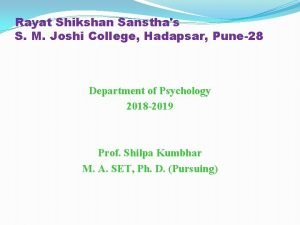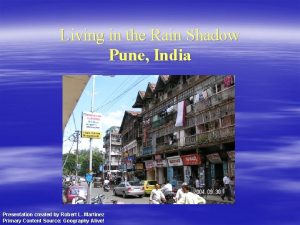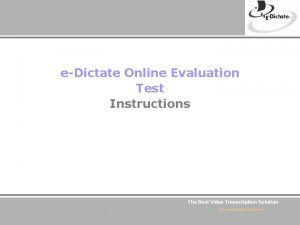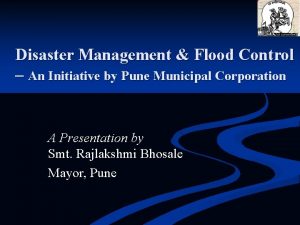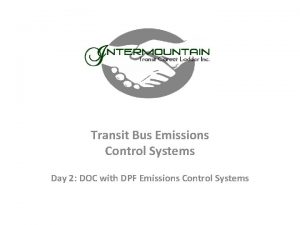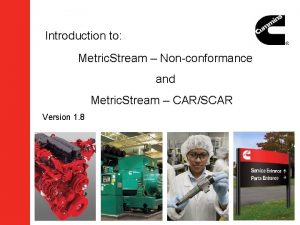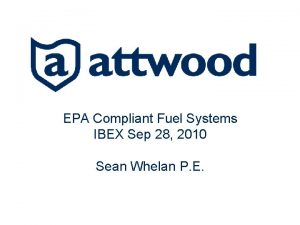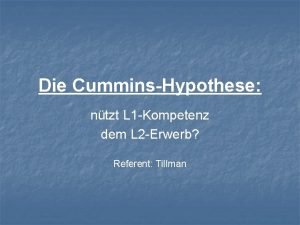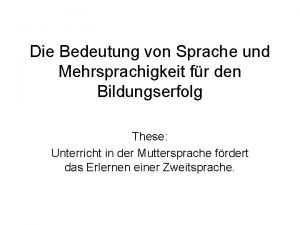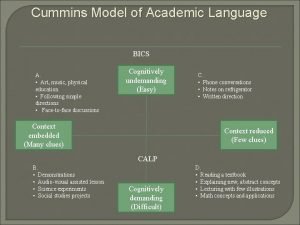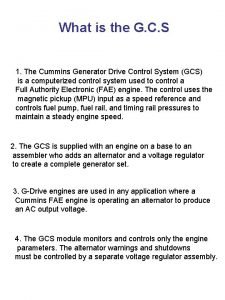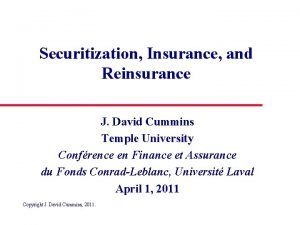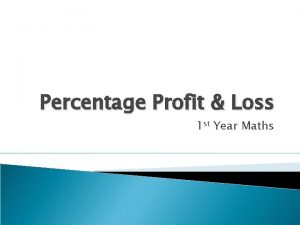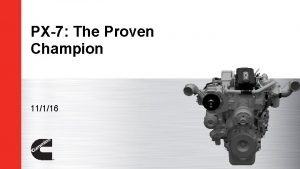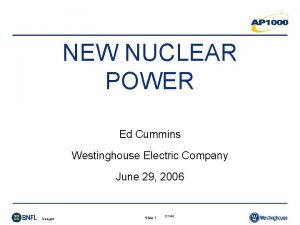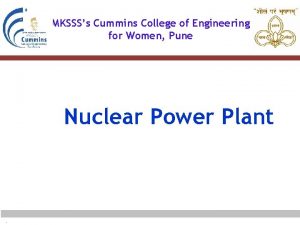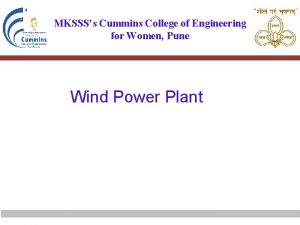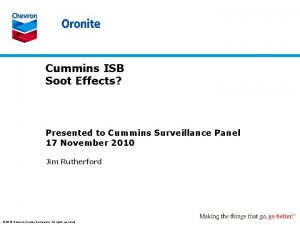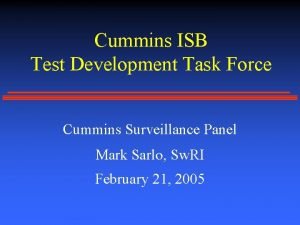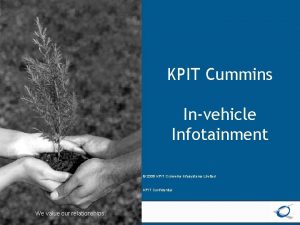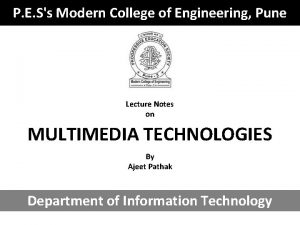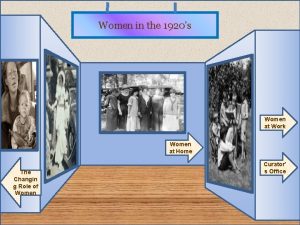MKSSSs Cummins College of Engineering for Women Pune






































































- Slides: 70

MKSSS’s Cummins College of Engineering for Women, Pune Power Plant Economics & Tariff Cummins College .

IMPORTANT TERMS RELATED TO ECONOMICS OF GENERATION Connected load : The sum of the continuous ratings of all the equipments connected to the power system is called connected load. Maximum Demand : The load on the power station is not constant, it varies from time to time The greatest of all the demands (loads) which occur during a given period is called maximum demands. Cummins College

Types of loads • • • Residential Commercial Industrial Irrigation Traction – Railways Municipal Cummins College

Terms and Definitions • Connected Load – Sum of the ratings of all equipment connected to load in k. W • Maximum Demand – Maximum demand will be equal to be all the connected load runs at fullest extent simultaneously. Cummins College

DEMAND FACTOR The ratio of maximum demand on the system to the rated connected load to the system is called demand factor. Mathematically , Demand factor = Maximum demand Connected load The actual maximum demand is always less than the rated load connected to the system , therefore, demand factor is always less than unity. Cummins College

AVERAGE LOAD The average of all the loads occurring at the various instants on the generating station is called average load. Or The total electrical energy (in WH or KWH) delivered in a given period divided by the time ( in hours) is that period , called average load. Daily average load = k. Wh energy supplied in day 24 Monthly average load= k. Wh energy supplied in month 24 x 30 Cummins College

LOAD FACTOR The ratio of average load to the maximum load is called load factor. Load factor = Average load Maximum load Since the average load is always less than maximum load , therefore, load factor is always less than one. Load factor is generally used for determining the average load or energy delivered by the generating station in a given period. Cummins College

DIVERSITY FACTOR • Various types of consumers are connected to the power station and usually their maximum demands do not occur at the same instant, • Therefore, the sum of individual maximum demands of all the consumers is always more than the actual maximum demand occurring on the generation stating • The ratio of sum of individual maximum demands of all the consumers connected to the generating station to the maximum demand on the power station is called diversity factor. Cummins College

DIVERSITY FACTOR • Cummins College

Utilization Factor • Cummins College

Plant Use Factor • Ratio of actual energy produced to the maximum energy that can be produced in given time • E = Energy produced in given time • C = Plant capacity • t = Actual time the plant is in operation Cummins College

Plant Capacity Factor • Cummins College

Plant Capacity Factor • Cummins College

Load Curve • Is a graphic reorientation showing power demand at every instance of time interval • Area under the curve represents the energy generated in given time. Cummins College

Load Duration Curve • Rearrangements of all load elements of chronological load curve in descending order Cummins College

Principles of Power Plant Design • • Simplicity of design Low capital cost Low cost of electricity generated High efficiency Low maintenance cost Low operating cost Reliability of power generation Reserve capacity to meet future demands Cummins College

Location of Power plant • Centre of electrical Load – In the vicinity of industries – Nearer to the center of load • Nearness to fuel source – Saves fuel transmission cost – Thermal power plant near to the coal mines • Availability of water – Water to generate steam – To cool the exhaust steam – Near to lake, river or sea Cummins College

Cost Analysis • Capital or Fixed Cost – – – Initial Cost Interest Depriciation Taxes Insurance • Operational Cost – – Fuel Cost Labor Cost Maintenance cost Supplies Cummins College

Cost Analysis. . • Initial Cost – Includes lad cost, Construction cost, equipment cost, installation cost • Interest – A power station is constructed by investing a huge capital. This money is generally borrowed from banks or other financial institutions and the supply company has to pay the annual interest on this amount. This may vary from 4% to 8% per annum Cummins College

• Depreciation – The decrease in the value of the power plant equipment and building due to constant use is known as depreciation. – Due to depreciation the plant has to be replaced by the new one after its useful life. Therefore, suitable amount must be set aside every year so that by the time the plant retires, the collected amount by way of depreciation equals the cost of replacement Cummins College

• Interest on Working Capital – Working Capital primarily for purchase of fuel has to be maintained at all times so that the generation does not suffer due to shortage of working capital • Insurance Premium Payable – All insurance payments reasonably paid to cover • • transportation risks, erection risks, Fire risks etc and any such risk shall be recovered from the consumers. Cummins College

• Tax and Duties: – Tax on income stream of the company, Banking cash transaction charge, any other direct tax and Fringe benefit tax shall be computed as expenses Shall be recovered as pass through from consumers and beneficiaries – Govt. duties shall be recovered at specified rate from the consumers but shall be processed on to the Govt. • Employees cost – Employee cost shall include the expenses on account of salaries & wages, staff welfare expenses, travelling expenses, Bonus etc including Directors remuneration. Cummins College

Variable/Operational Cost • Cost of fuel – Unit Price of fuel – Amount of energy produced – Plant efficiency • Maintenance and repair cost • Labor • Supplies – Other than fuel, tools, cleaning material, chemicals, paints etc. Cummins College

Performance of power plant • Cummins College

Input Output Curve • In order to keep the apparatus functioning at zero load, a certain input (Io) is required to meet functional and heat loss. Cummins College

Heat Rate & Incremental Curve Cummins College

Heat Rate & Incremental Curve

Economical Load Sharing • Two generators sharing load • Plot of Combined input vs Load on generator ‘A’ • The point of minimum input can be obtained. • This represents the economical loading • The incremental rate of the generators should be same.

TARIFF The rate of electrical energy at which it is sold to the consumers is called tariff. The supply companies invest money to generate, transmit and distribution of electrical energy, a tariff is fixed. The cost of generation depends upon the magnitude of energy consumed by the consumers and his load conditions. Therefore, due consideration is given to different types of consumers (e. g. domestic, commercial and industrial) while fixing a tariff. Cummins College

OBJECTIVES OF TARIFF The main objective of the tariff is to ensure the recovery of the total cost of generation and distribution. Tariff should include the following items: (1) Recovery of cost of electrical energy generated at the generating system. (2) Recovery of cost on the capital investment in transmission and distribution system. (3) Recovery of cost of operation, supplies and maintenance of equipment. Cummins College

OBJECTIVES OF TARIFF (4) Recovery of cost of metering equipment, billing and miscellaneous services. (5) A marginal return (Profit) on the capital investment. Cummins College

MAIN FACTORS INVOLVED IN FIXING A TARIFF The following are the principal factor involved in fixing a tariff: (1) The tariff should ensure the recovery of the total cost of generation, transmission, and distribution etc. (2) The tariff should be simple, cheap and capable of easy explanation to consumers. (3) The tariff should be attractive so that consumers are encouraged to make more extended use of electrical energy. Cummins College

INTRODUCTION to tariff • The electrical energy produced at the generating station is delivered to a large number of consumers. • The rate at which energy is sold to the consumers (called tariff) is fixed by the supplying company. • The supply companies are to ensure that they should not only recover the total cost of producing the energy but also earn some profit. • However, the profit should be minimum possible so that electrical energy can be sold at reasonable rates and the consumers insured to use more electricity. Cummins College

MAIN FACTORS INVOLVED IN FIXING A TARIFF (4) The tariff should be such that it would earn a reasonable profit. (5) The tariff must be fair and the consumers should be charged according to what the energy costs. Cummins College

TYPES OF TARIFF There are various types of consumers ( domestic, commercial and industrial etc. ) and their energy requirements are also different. Accordingly, several types of tariffs have been designed so far, out of which the most commonly applied are described below: Cummins College

TYPES OF TARIFF SIMPLE TARIFF FLAT RATE TARRIF BLOCK RATE TARIFF TWO-PART TARIFF MAXIMUM DEMAND TARIFF POWER FACTOR TARIFF Cummins College

SIMPLE TARIFF Simple Tariff: The tariff in which the rate per unit of energy is fixed, is called simple tariff. This is a simplest possible tariff. The rate per unit of energy consumed by the consumer is fixed irrespective to the quantity of energy consumed by a consumer. This energy consumed is measured by installing an energy meter. Cummins College

ADVANTAGES The following are the advantages : 1. It is in simplest form and easily understood by the consumers. 2. Consumer is to pay as per his consumption. Cummins College

DISADVANTAGES 1. Consumer is to pay the same rate per unit of energy consumed irrespective of the number of units consumed by him. Hence, consumers are not encourage to consume more energy. 2. The cost of energy per unit delivered is high. 3. The supplier do not get any return for the connection given to the consumer if consumer does not consume any energy in a particular month. Cummins College

APPLICATION OF SIMPLE TARIFF Since it is very simple form of tariff, it is generally applied to tube wells which are operated for irrigation purposes Cummins College

FLAT RATE TARIFF • The tariff in which different types of consumers are charged at different per unit rates is called flat rate tariff. • This type of tariff is similar to simple tariff. Only difference is that consumers are grouped into different classes and each class of consumer is charged at a different per unit rate. For example flat rate for fan and light loads is slightly higher than that for power loads. Cummins College

ADVANTAGES (1) It is more fair to different types of consumers. ( 2) It is quite simple in calculations. Cummins College

DISADVANTAGES (1) Consumers are not encouraged to consume more energy because same rate per unit of energy consumed is charged irrespective of the quantity of energy consumed. (2) Separate meters are required to measured energy consumed for light loads and power loads. (3) The suppliers does not get any return for the connection given to the consumer if he does not consume any energy in a particular period or month. Cummins College

APPLICATION OF FLAT RATE TARIFF Since it is simple and easy for explanation to consumers, therefore this tariff is generally applied to domestic consumers. Cummins College

BLOCK RATE TARIFF The tariff in which first block of energy is charged at a given rate and the succeeding blocks of energy are charged at progressively reduced rates is called block rate tariff Cummins College

BLOCK RATE TARIFF • In this type of tariff, the energy units are divided into numbers of blocks and the rate per unit of energy is fixed for each block. • The rate per unit of energy for the first block is the highest and reduces progressively with the succeeding blocks. • For example, the first 100 units may be charged at the rate of Rs. 3. 00 per unit; the next 100 units may be charged at the rate of Rs. 2. 50 per unit and the remaining additional units may charged at the rate of Rs. 2. 00 per unit. Cummins College

ADVANTAGES (1) By giving an incentive, the consumers are encouraged to consume more energy. This increases the load factor of the power system and hence reduces per unit cost of generation. (2) Only one energy meter is required to measure the energy. Cummins College

DISADVANTAGES (1) The supplier does not get any return for the connection given to the consumer if consumer does not consume any energy in a particular period. Cummins College

APPLICATION OF BLOCK RATE TARIFF This type of tariff is mostly applied to domestic and small commercial consumers. Cummins College

TWO – PART TARIFF The tariff in which electrical energy is charged on the basis of maximum demand of the consumer and the units consumed by him is called two- part tariff. Cummins College

TWO- PART TARIFF • In this tariff, the total charges to be made from the consumer are split into two components namely fixed charges and running charges. • The fixed charges are independent of energy consumed by the consumer but depend upon the maximum demand, • The running charges depend upon the energy consumed by the consumer. The maximum demand of the consumer is assessed on the basis of the k. W capacity of all the electrical devices owned by a particular consumer or on the connected load. Cummins College

TWO-PART TARIFF Thus, the consumer is charged at a certain amount per k. W of energy is consumed i. e. Total charges= Rs. (a X k. W + b X k. Wh ) where, Rs. a= charges per k. W of maximum demand Rs. b= charges per k. Wh of energy consumed Cummins College

TWO- PART TARIFF • In this tariff the charges made on maximum demand recovers the fixed charges of generation. • Whereas, the charges made on energy consumed, recovers operating cost which varies with variation in generated (or supplied) energy. Cummins College

ADVANTAGES (1) It is easily understood by the consumers. (2) The supplier gets the return in the form of fixed charges for the connection given to the consumer even if he does not consume any energy in a particular period. Cummins College

DISADVANTAGES (1) If a consumer does not consume any energy in a month even then he has to pay the fixed charges. (2) Since the maximum demand of consumer is not measured, therefore, there is always conflict between consumer and the supplier to assess the maximum demand. Cummins College

MAXIMUM DEMAND TARIFF • The tariff in which electrical energy is charged on the basis of maximum demand of the consumer • This tariff is actually similar to two-part tariff with only difference that the maximum demand is actually measured by installing a maximum demand indicator meter. Thus the draw-back of two-part tariff is removed. Cummins College

APPLICATION OF MAXIMUM DEMAND TARIFF This tariff is mostly applied to bulk supplies and large industrial consumers. Cummins College

POWER FACTOR TARIFF • The tariff in which power factor of the consumer’s load is also taken into consideration while fixing it, is called power factor tariff. • Power factor plays an important roll in a. c. system. • A low power factor increases the rating of power plant equipment and gives higher losses. Therefore, consumers are advised to operate their loads at higher power factor. Cummins College

KVA MAXIMUM DEMAND TARIFF In this case the fixed charges are made on the basis of maximum demand in KVA instead of KW. Therefore, a consumer having low power factor has to pay more fixed charges. Thus the consumers are encouraged to operate their loads at higher power factor. So in these day suppliers ask consumer to use shunt capacitors to improve power factor. Cummins College

KWH & KVARH TARIFF In this tariff, the consumers are charged for KWH and KVARH separately. Therefore, a consumer having low power factor shall have to pay more charges. Cummins College

SLIDING SCALE TARIFF In this case, an average power factor , say 0. 8 lagging, is taken as reference. If the power factor of the consumer is below the reference, an additional amount is charged from the consumer as a penalty. On the other hand, if the power factor is above the reference, a discount is allowed to the consumer as a gift. Cummins College

APPLICATION OF SLIDING SCALE TARIFF The power factor tariff is mostly applied to large industrial consumers. Cummins College

BLOCK RATE TARIFF WITH MINIMUM FIXED CHARGES • Tariff in which number of blocks (usually three blocks) of energy are formed which are charged at different rates. • However if the energy consumed by the consumer is low, he is being charged on the basis of minimum charges made per KW of his maximum demand. Cummins College

RULES • number of blocks and the rate per unit of energy is fixed for each block. • In our state, the rate per unit of energy for the first block is minimum and increases progressively with the succeeding blocks. • This method is adopted to help the low income group for the utilization of electrical energy. Cummins College

ADVANTAGES (1) It helps the consumers of low income group to use electrical energy at low rates. (2) The consumers uses electrical energy as per requirement and wastage of energy causes more bills. (3) Only one meter is required to measure energy. (4) It is quite easy to understand. Cummins College

DISADVANTAGES (1) The consumers using more energy are charged at higher rate than normal rates. (2) The consumers are to pay the fixed charges unnecessarily even when they do not consume energy at all in a month. Cummins College

APPLICATION OF BLOCK RATE TARIFF This tariff is very popular in the country like INDIA. Cummins College

FIXING A TARIFF IN INDIA In India, supply of electrical energy is a State affair. Therefore, the States are empowered to fix up the tariff. Most of States impose Education Tax Sale Tax Development Tax This increases the rate of energy. Cummins College

FIXING A TARIFF IN INDIA Most of states deliver energy to the weaker section at low rates and increase the rates for middle and upper class consumers. Sometimes, State like Punjab deliver energy to a particular section free of cost for rapid development of that section or to fulfill some political motives. Cummins College

THANKS Cummins College
 Sm joshi college pune
Sm joshi college pune Cauvery college for women
Cauvery college for women Psgr krishnammal college
Psgr krishnammal college Welcome to pune in marathi
Welcome to pune in marathi Masat mbrojtese ne pune
Masat mbrojtese ne pune Pune, india, has tried to increase its rainfall by
Pune, india, has tried to increase its rainfall by Edictate pune
Edictate pune Flood control pune
Flood control pune Ddhs pune
Ddhs pune Sadhana vidyalaya hadapsar
Sadhana vidyalaya hadapsar German language classes in pune
German language classes in pune Cost of test tube baby in pune
Cost of test tube baby in pune Urethra
Urethra Sci-edge abstracts
Sci-edge abstracts Inductanta mutuala
Inductanta mutuala Lokmanya orthopedic hospital pune
Lokmanya orthopedic hospital pune Pune me projekt
Pune me projekt Om chambers bhosari
Om chambers bhosari Afosop pune
Afosop pune Iist pune
Iist pune Pune branch of wirc
Pune branch of wirc Def dosing unit relay
Def dosing unit relay Fuel system components
Fuel system components Threshold theory bilingualism
Threshold theory bilingualism Quick serve maintenance
Quick serve maintenance Metric stream
Metric stream Cummins isx aftertreatment fuel shut off valve location
Cummins isx aftertreatment fuel shut off valve location Ntzt
Ntzt Interdependenzhypothese beispiel
Interdependenzhypothese beispiel Cummins power unit
Cummins power unit Language
Language Cummins scholarship registration
Cummins scholarship registration Universal grammar
Universal grammar Isfjellmodellen
Isfjellmodellen Gce cummins
Gce cummins Cummins model of academic language
Cummins model of academic language Cummins gcs
Cummins gcs Cummins supplier portal
Cummins supplier portal Cummins insurance
Cummins insurance Percentage profit and loss questions
Percentage profit and loss questions Cummins power unit
Cummins power unit Brett merritt cummins
Brett merritt cummins Cummins px7
Cummins px7 Etotals ibm
Etotals ibm Arkansas
Arkansas Ed cummins
Ed cummins Cpp cummins
Cpp cummins Holly cummins
Holly cummins Iso 22301 utbildning
Iso 22301 utbildning Novell typiska drag
Novell typiska drag Nationell inriktning för artificiell intelligens
Nationell inriktning för artificiell intelligens Vad står k.r.å.k.a.n för
Vad står k.r.å.k.a.n för Varför kallas perioden 1918-1939 för mellankrigstiden
Varför kallas perioden 1918-1939 för mellankrigstiden En lathund för arbete med kontinuitetshantering
En lathund för arbete med kontinuitetshantering Underlag för särskild löneskatt på pensionskostnader
Underlag för särskild löneskatt på pensionskostnader Tidböcker
Tidböcker Sura för anatom
Sura för anatom Vad är densitet
Vad är densitet Datorkunskap för nybörjare
Datorkunskap för nybörjare Boverket ka
Boverket ka Debatt artikel mall
Debatt artikel mall Delegerande ledarstil
Delegerande ledarstil Nyckelkompetenser för livslångt lärande
Nyckelkompetenser för livslångt lärande Påbyggnader för flakfordon
Påbyggnader för flakfordon Arkimedes princip formel
Arkimedes princip formel Svenskt ramverk för digital samverkan
Svenskt ramverk för digital samverkan Kyssande vind
Kyssande vind Presentera för publik crossboss
Presentera för publik crossboss Teckenspråk minoritetsspråk argument
Teckenspråk minoritetsspråk argument Kanaans land
Kanaans land Klassificeringsstruktur för kommunala verksamheter
Klassificeringsstruktur för kommunala verksamheter
